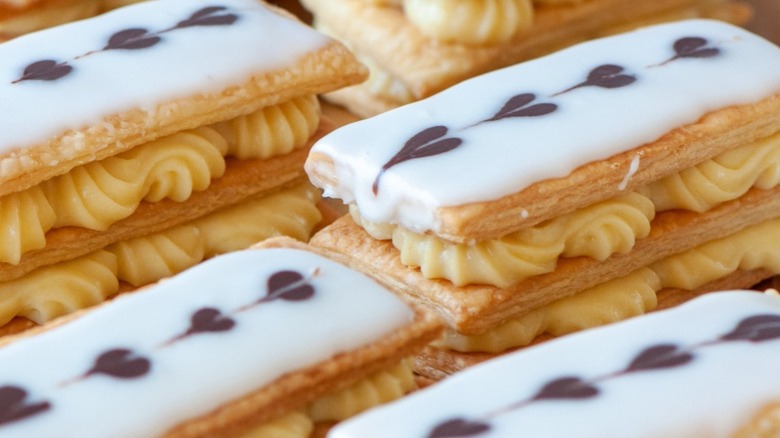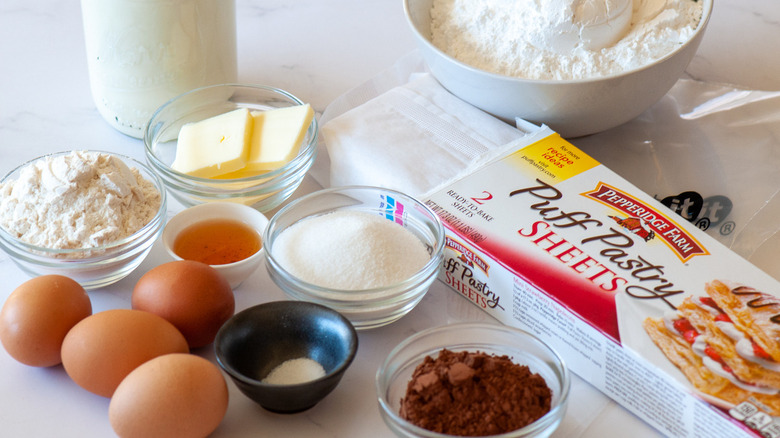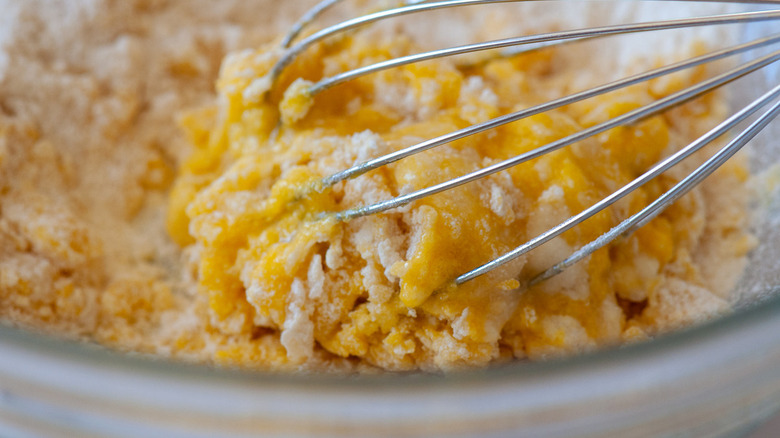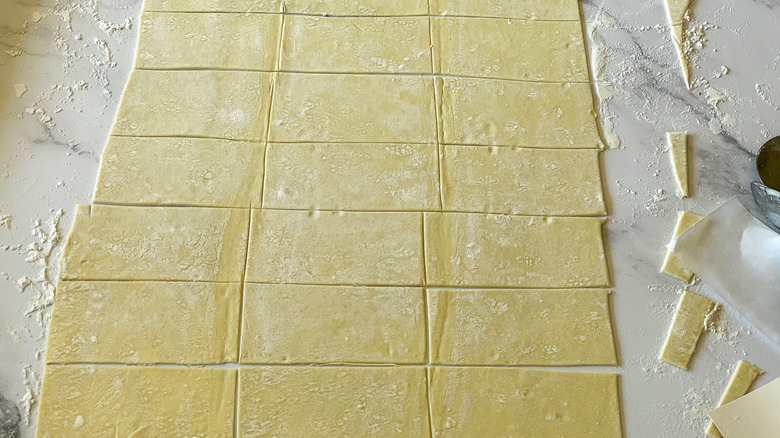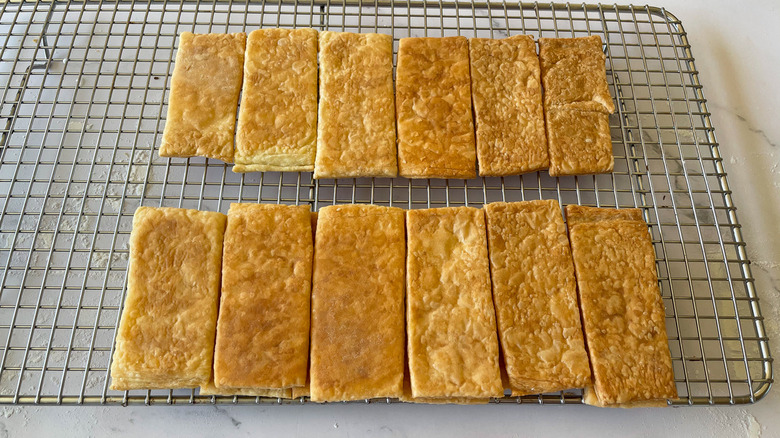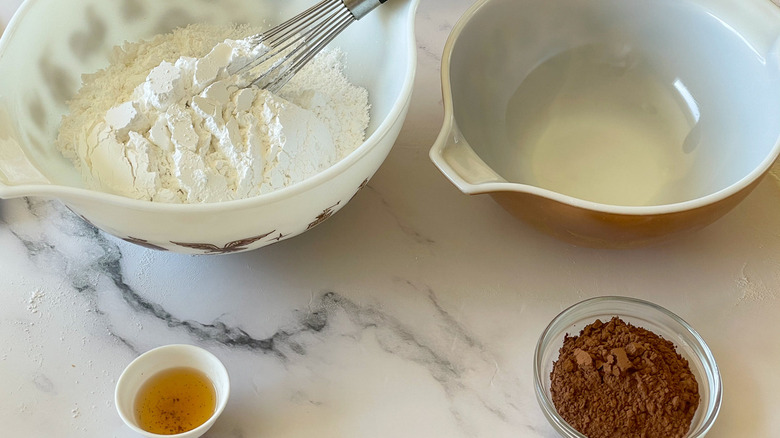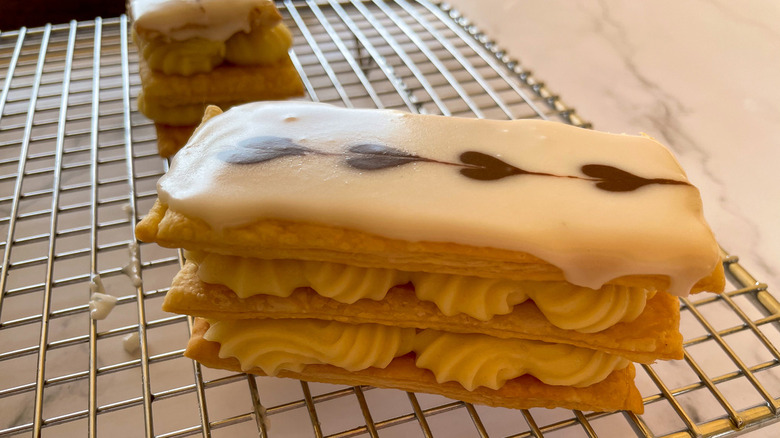Shortcut Mille Feuille Recipe
A mille feuille, which takes its name from the French phrase meaning "thousand sheets," is a lovely, delicate French pastry that is often mistaken for the very similar Napoleon. Although the two pastries appear identical, Preppy Kitchen points out that Napoleons are typically prepared with almond-flavored pastry cream, while mille feuilles are flavored with vanilla cream.
While mille feuilles may look like they'd be almost impossible for anyone but a professional pastry chef to make, recipe developer Laura Sampson of the Little House Big Alaska blog lets us in on a little secret: These are actually quite doable if you start with frozen puff pastry. Yes, you're allowed to do this! Even if you're a real do-it-yourselfer, making your own puff pastry just sets the bar a bit too high if you're in a time crunch.
Once you take the pastry-making out of the equation, the rest of the recipe, Sampson says, is "not hard work," although she does admit "it's a lot of fussy work," so it will take some time. The most difficult part may actually be figuring out how to pronounce mille feuille properly without sounding like you slept through your high school French class. According to YouTuber Julien Miquel, it should sound something like "MEEL-foya," but you might need to practice it a few times in order to introduce your pastries with the proper French flair.
Gather the ingredients to prepare mille feuille
Unless you're an old hand at making flaky pastry-based things, you may not have puff pastry sheets in the freezer, and you may not even be entirely sure where to find them. Frozen puff pastry can usually be found in the supermarket frozen dessert section, perhaps in the general neighborhood of the Cool Whip. Sampson says she used the Pepperidge Farm brand to prepare her mille feuilles, and this recipe calls for just one sheet, or half of a 17.3-ounce package.
The rest of the ingredients are pretty basic pantry items you may already have on hand: eggs (you're only using one whole one, plus three yolks), cornstarch or all-purpose flour, granulated sugar, salt, milk, vanilla extract, softened unsalted butter, powdered sugar, and cocoa powder.
Prepare the vanilla pastry cream
The pastry cream, as opposed to the frosting, is the custardy filling that goes between those (not quite) thousand sheets of pastry. You'll start off by putting the eggs (whole and yolks) into a bowl, then sifting the dry ingredients over them. Sampson says you can either use cornstarch or all-purpose flour, but be sure to note the different amounts of each. This is due to cornstarch having superior thickening abilities, but if you don't have any on hand, the larger amount of flour will work just fine. Whisk the ingredients together, and then set them aside.
Warm 2 cups of milk with 2 teaspoons vanilla over medium until just bubbling but not boiling. Remove from the heat, and pour half the milk over the eggs, whisking constantly. Pour the egg/milk mix into the rest of the milk, return it to the stove and cook, whisking, over medium heat until it's just beginning to boil. Turn down the heat to low, and cook for another minute or two until there's no more flour/cornstarch flavor. Then, remove the mixture from the stovetop, and stir in the butter. Strain the custard into a sieve placed over a bowl, pressing it down through the sieve in order to get the lumps out. Cover the bowl with plastic wrap, and refrigerate the pastry cream for two hours.
Cut out the puff pastry pieces
Once the pastry cream is in the fridge, you can get to work on the pastry itself. It will help if you first make a template measuring 2x4 inches out of cardboard or paper. The sheet of puff pastry will need to thaw for some time before you can work on it — Sampson says that 45 minutes on the kitchen counter should do it. Once it's thawed, unfold the sheet and gently press any tears back together. Roll the dough out to a rectangle that's roughly 12x14 inches and 1/16-inch thick. Sampson says you'll need to cut out, at minimum, 24 2x4-inch pastry rectangles, but says rolling the sheet out to these dimensions should make "a few extra in case you burn some."
When you cut out the rectangles using the template, don't worry if they're a bit raggedy. Sampson reassures, "They don't need to be precise, because puff pastry has a way of getting out of shape in the oven." You can always trim the cooked pastry, if needed.
Bake the puff pastry
While you're cutting out the rectangles, or even before you start, you can preheat the oven to 400 F so you'll be ready to bake the pastry as soon as it goes "ding," "buzz," or whatever sound your oven makes. Get out your biggest baking sheet, and line it with parchment paper. Then, lay as many rectangles on the sheet as you can without crowding them too much. Cover the pastry with another sheet of parchment paper, then place another baking sheet on top. Sampson explains this extra baking sheet will weight the pastry down and prevent it from getting too puffy.
Bake the first batch of pastry rectangles for 11 to 14 minutes until they are crispy and cooked all the way through. Remove them to a cooling rack while you prepare another pan for the remaining dough rectangles, and repeat the whole process. Let the pastry cool thoroughly before you assemble the mille feuilles.
Make the icing for the tops of the mille feuilles
Don't start making the icing until you're just about ready to put the mille feuilles together. Once the pastry cream is sufficiently chilled and set, and all of the puff pastry pieces are cool, put the powdered sugar into a bowl. Mix in the remaining 2 teaspoons of vanilla along with just as much milk as you need to make a thick frosting. To prepare the chocolate icing, first remove ½ cup of the vanilla icing to a separate bowl. Then, add in the cocoa powder along with enough milk to return it to the same consistency as the vanilla icing. Thick, but spreadable, is what you're going for here.
Put the mille feuilles together
Put the pastry cream and the chocolate icing into piping bags or Ziploc bags with one corner snipped off, using a large one for the cream and a small one for the icing. Stack the pastry rectangles in sets of three, trying to match the sizes as best you can. Line the stacks up on the cooling racks, then remove the top rectangle from each stack and frost each of the top pieces with the vanilla icing. Next, place three to four dots of the chocolate icing on each frosted pastry piece, and drag a toothpick through the dots to make swirls or heart shapes in the frosting.
Once you have frosted all eight top pieces, let them dry while you spread the cream over the bottom pastry piece of each stack. Lay another pastry piece on top, then cover this piece with pastry cream as well. The frosted rectangles will go on top, giving you a pastry with two layers of cream filling and one frosted layer.
Sampson cautions, "Serve [the mille feuilles] within several hours or the puff pastry will lose its crispness." She does say, though, that you should be able to prepare both the pastry cream and the puff pastry in advance. But, note that you shouldn't put the pastries together until you're ready to enjoy them. If you'd like a beverage to accompany your mille feuilles, Sampson says, "I think these would [be] best served with a nice cup of coffee or tea."
Shortcut Mille Feuille Recipe Is The Pastry Dish You've Been Waiting For
While mille feuilles may look impossible for anyone but a professional pastry chef to make, this recipe proves that wrong by using frozen puff pastry.
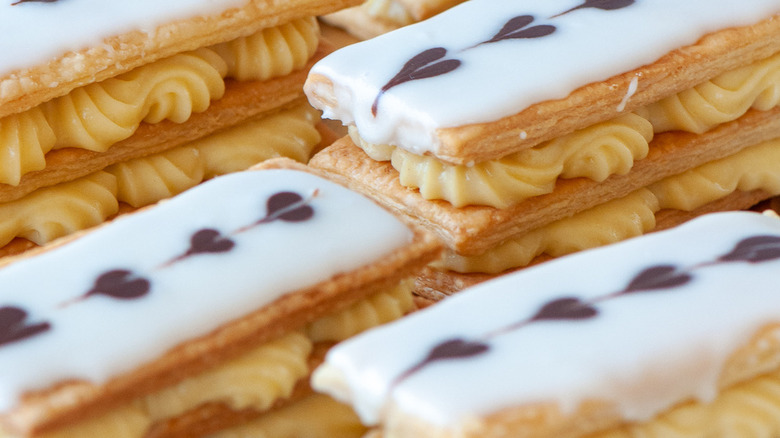
Ingredients
- 3 tablespoons cornstarch or 7 tablespoons all-purpose flour
- 6 tablespoons granulated sugar
- pinch of salt
- 3 egg yolks
- 1 whole egg
- 2 ¼ cups milk, divided
- 4 teaspoons vanilla extract, divided
- 3 tablespoons unsalted butter
- ½ package (1 sheet) frozen puff pastry, thawed
- 3 cups powdered sugar
- 1 to 2 tablespoons cocoa powder
Directions
- Sift the corn starch or flour, sugar, and salt over the eggs. Whisk to combine, then set aside.
- Warm 2 cups of milk and 2 teaspoons of vanilla extract over medium heat until the milk is bubbly, but not boiling.
- Remove milk from the heat, and pour half the milk over the egg mixture, whisking constantly.
- Pour the egg mixture into the pan with the remaining milk. Return to heat, and whisk constantly over medium heat until the mixture is barely boiling.
- Reduce the heat to low, and cook 1 to 2 minutes more, then remove from the heat, and stir in the butter.
- Pour the custard into a sieve set over a bowl, and press it through to remove the lumps.
- Cover the bowl with plastic wrap, and chill for 2 hours.
- Make a template for the puff pastry by cutting a 2x4-inch piece of cardboard or paper.
- Thaw the puff pastry on the counter for at least 45 minutes.
- Unfold the pastry sheet, press any tears back together, and roll out to a rectangle roughly 12x4 inches and 1/16-inch thick. Cut the pastry into 24 2x4-inch rectangles.
- Preheat the oven to 400 F.
- Line a baking sheet with parchment paper, and fill it with pastry pieces. Cover with more parchment and another baking sheet.
- Bake the rectangles for 11 to 14 minutes until crispy and baked through.
- Let the baked pastry cool on a wire rack while you repeat the baking process with the remaining puff pastry pieces, then set those aside to cool, too.
- When you're ready to serve the pastry, mix the powdered sugar with the remaining vanilla and just enough milk to make a thick icing.
- Scoop ½ cup of icing into a small bowl, and stir in the cocoa powder along with enough milk to return the chocolate icing to the same consistency as the vanilla icing.
- Fill a piping bag or a Ziploc bag with the pastry cream and a smaller one with the chocolate frosting. If you're using the Ziploc bag, snip off one corner.
- Sort the puff pastry rectangles into stacks of three, matching the sizes as best you can.
- Frost the top piece of each stack with the vanilla icing, then place three to four dots of chocolate icing on top of the vanilla. Use a toothpick to swirl the chocolate into the vanilla.
- Layer the bottom piece of pastry in each stack with pastry cream, then add the middle pastry layer, and top that with another layer of cream. Finish off with the frosted piece of pastry.
- Repeat the assembly process with all eight mille feuilles.
- Serve the mille feuilles within several hours of assembly for the best texture.
Nutrition
| Calories per Serving | 419 |
| Total Fat | 14.4 g |
| Saturated Fat | 6.2 g |
| Trans Fat | 0.2 g |
| Cholesterol | 93.1 mg |
| Total Carbohydrates | 67.8 g |
| Dietary Fiber | 0.7 g |
| Total Sugars | 57.3 g |
| Sodium | 98.2 mg |
| Protein | 5.3 g |
